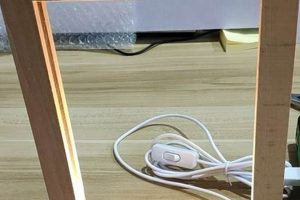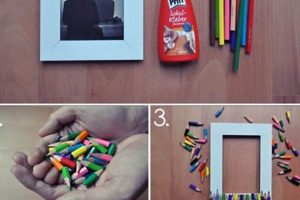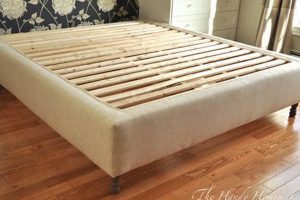Creating a picture surround with an aged or antique aesthetic through do-it-yourself methods involves various techniques. This can encompass repurposing existing materials, applying distressing finishes to new wood, or combining elements from different eras. As an example, an individual might take a modern wooden photo holder and use sandpaper and stain to give it the appearance of having been crafted decades ago.
The practice offers a cost-effective means of acquiring unique dcor items and personalizing living spaces. Furthermore, this creative pursuit promotes sustainability through the upcycling of discarded materials. Historically, handcrafted picture holders reflected available resources and artisanal skills, thus imbuing modern recreations with a sense of connection to past crafting traditions.
The following sections will delve into specific methods for achieving this aesthetic, including detailed instructions on material selection, aging techniques, and embellishment strategies to produce desired results.
DIY Vintage Frame
Achieving an authentically aged appearance for a picture surround requires careful consideration of materials and techniques. The following tips provide valuable insights for crafting a convincing and aesthetically pleasing result.
Tip 1: Material Selection: Opt for wood with visible grain patterns. Pine, oak, or reclaimed lumber offer a superior base for distressing techniques compared to composite materials.
Tip 2: Surface Preparation: Before applying any finish, lightly sand the wood to create a slightly roughened surface. This enhances the adherence of subsequent layers of paint or stain.
Tip 3: Layering Techniques: Apply multiple thin coats of paint, allowing each layer to dry completely before proceeding. This approach facilitates controlled distressing and creates depth of color.
Tip 4: Distressing Methods: Employ techniques such as sanding, dry brushing, and the application of antiquing glaze to simulate wear and tear. Experiment with different tools and pressure levels to achieve varying effects.
Tip 5: Hardware Considerations: Utilize aged or reproduction hardware to complement the overall aesthetic. Options include rusted nails, antique brass hinges, and tarnished metal fasteners.
Tip 6: Crackle Finish Application: Introduce a crackle medium between layers of paint to create a network of fine cracks. This simulates the natural aging process of varnishes and lacquers.
Tip 7: Sealing and Protection: Apply a protective clear coat or wax finish to seal the aged surface and prevent further deterioration. Matte finishes are generally preferred to maintain an authentic appearance.
By implementing these strategies, one can effectively transform ordinary materials into convincing reproductions of aged picture surrounds, adding character and historical depth to displayed artwork or photographs.
With a solid foundation in these core principles, exploration into advanced distressing techniques and embellishment options can be undertaken with confidence.
1. Material Selection
The selection of appropriate materials is paramount to the success of a do-it-yourself aged picture surround endeavor. The inherent properties of different substances directly influence the final aesthetic and structural integrity of the piece. For instance, utilizing reclaimed wood imparts an immediate sense of authenticity due to its pre-existing wear, grain patterns, and potential imperfections. Conversely, new, untreated wood requires deliberate aging techniques to replicate a comparable visual effect. The choice of material thus dictates the subsequent procedures involved in achieving the desired antique appearance. The materials ability to accept paint, stain, and other distressing agents is also a crucial consideration. An unsuitable surface may resist these treatments, resulting in an unsatisfactory or uneven finish.
Consider the common practice of employing pine for such projects. Its soft grain facilitates controlled sanding and distressing, allowing for the creation of worn edges and simulated woodworm damage. Conversely, hardwoods like oak, while durable, necessitate more vigorous methods to achieve similar results. Furthermore, the selection process extends beyond the wood itself. The type of adhesive used in assembly impacts the longevity of the structure, and the choice of backing materials influences the preservation of the framed artwork or photograph. Acid-free backing boards, for example, prevent the degradation of paper-based items over time. The integration of aged or reproduction hardware, such as nails, screws, and decorative elements, further enhances the overall antiquated aesthetic.
In summary, informed material choices are indispensable for producing a convincing and enduring aged picture surround. An understanding of the properties of various materials, their compatibility with aging techniques, and their impact on structural integrity and archival preservation is crucial for achieving professional-quality results. Neglecting these considerations may lead to a substandard outcome, undermining the overall aesthetic and potentially compromising the long-term care of the framed item.
2. Distressing Techniques
Distressing techniques form an integral component of replicating an aged or antique aesthetic in do-it-yourself picture surround projects. The application of these methods simulates the effects of time, environmental exposure, and handling, imbuing a newly constructed or repurposed item with the visual characteristics of age. Without the deliberate introduction of artificial wear, a newly created picture surround will invariably appear modern, lacking the patina and character sought in a vintage-inspired piece. A direct cause-and-effect relationship exists: the execution of techniques such as sanding, staining, and crackling directly causes the transformation of a pristine surface into one exhibiting signs of age.
For instance, consider the practical application of dry brushing. This technique involves lightly applying a small amount of paint to a brush and then wiping most of it off before dragging it across the surface of the picture surround. The result is a subtle, uneven layer of color that mimics the wear patterns found on aged furniture or artwork. Similarly, the use of antiquing glazes adds depth and richness to the finish, highlighting crevices and simulating the accumulation of dirt and grime over time. Sanding, specifically targeted sanding of edges and corners, creates the appearance of natural wear caused by repeated handling. The selection and application of specific techniques must align with the desired end result, taking into consideration the type of wood, the existing finish, and the overall aesthetic vision. An improper technique or application can result in an unconvincing or aesthetically displeasing outcome. Therefore, understanding the nuances of various distressing methods is crucial for achieving a believable and visually appealing vintage appearance.
In conclusion, mastering distressing techniques is not merely an optional step, but a critical requirement for successfully creating aged picture surrounds. These methods provide the means to transform ordinary materials into objects possessing a tangible history, contributing to the overall authenticity and visual appeal of the final product. Challenges may arise in achieving a balance between artificial wear and tasteful presentation, but a thorough understanding of techniques and careful execution will lead to a convincing and aesthetically pleasing result. This skill connects directly to the broader theme of historical reproduction and the creation of personalized dcor, enabling the crafting of unique and characterful pieces.
3. Hardware Aesthetics
The selection and integration of appropriate hardware significantly impact the perceived authenticity of a do-it-yourself aged picture surround. Hardware, encompassing nails, hinges, clasps, and decorative elements, functions not merely as functional components, but as visual indicators of age and historical style. Mismatched or incongruous hardware detracts from the overall effect, rendering the attempt at creating a vintage aesthetic unconvincing. A direct correlation exists between the accuracy of the hardware’s historical style and the perceived authenticity of the final product. For instance, employing modern, bright-finished screws in a picture surround intended to evoke the 19th century would create an immediate visual dissonance. Conversely, the use of hand-forged nails or reproduction antique brass hinges can significantly enhance the perceived age and craftsmanship of the piece.
Consider the practical example of constructing a reproduction Victorian-era picture surround. The utilization of machine-cut screws, a product of the industrial age, would be anachronistic. Instead, sourcing or creating reproduction rosehead nails, common in that period, would contribute to a more accurate and compelling representation. Furthermore, the application of aging techniques to the hardware itself is crucial. Tarnishing, rusting, or the application of antiquing solutions can simulate the effects of time and environmental exposure. The choice of finish, whether it be matte, brushed, or patinated, further refines the hardware’s aesthetic properties. This detail extends to seemingly minor elements such as the type of picture wire or the style of the hanging hook. Each component contributes to the overall impression of age and authenticity. The hardwares influence is considerable; it can elevate a basic project to a convincing vintage reproduction.
In conclusion, the aesthetic considerations surrounding hardware are indispensable for successful do-it-yourself aged picture surround projects. The careful selection, application of aging techniques, and accurate historical representation of hardware elements directly contribute to the overall authenticity and visual appeal. Overlooking this critical aspect compromises the integrity of the project and diminishes the desired effect. Hardware aesthetics, therefore, serve as a crucial bridge between functional necessity and stylistic authenticity, enabling the creation of compelling and historically informed pieces.
4. Finish Application
The judicious application of a finish is a defining step in crafting a convincing do-it-yourself aged picture surround. The finish serves not merely as a protective layer, but as a critical element in conveying the illusion of age and historical authenticity. The choice of finish and the technique of its application directly influence the final appearance, impacting color, texture, and sheen. A poorly selected or improperly applied finish can negate the effects of other distressing techniques, rendering the attempt at creating a vintage aesthetic unconvincing. The correct finish, conversely, enhances the overall impression of age and wear, solidifying the connection to a specific historical period or style. Therefore, the finish application represents a pivotal stage in the creation of aged picture surrounds. A direct example is the use of milk paint followed by a wax sealant. Milk paint provides a chalky, matte surface that readily accepts distressing techniques like sanding. The wax sealant then protects the paint while adding a subtle sheen that emulates the patina of aged furniture. If a modern polyurethane varnish were used instead, the resulting glossy finish would undermine all previous efforts to create an aged appearance.
Different finishes impart distinct visual characteristics associated with different eras. For example, shellac, a common finish in the 19th century, produces a warm, amber tone that darkens over time. Replicating this effect requires the use of amber-tinted shellac or similar products designed to mimic its color and reflective qualities. Crackle finishes, created by applying a crackle medium between layers of paint, simulate the natural aging process of varnishes and lacquers, producing a network of fine cracks that suggest the passage of time. The application of stains is another important consideration. Stains can be used to deepen the color of the wood, highlight grain patterns, or create a weathered effect. The selection of a stain that complements the desired aesthetic is crucial. For instance, a dark walnut stain might be appropriate for a Victorian-style picture surround, while a lighter, more transparent stain would be better suited for a farmhouse-style piece.
In summary, the skillful application of a finish is indispensable for achieving a convincing aged appearance in do-it-yourself picture surround projects. This process influences the visual characteristics of texture, color, and shine in a picture. Accurate selection and implementation ensure a good final outcome. Challenges may include matching specific historical finishes or perfecting distressing, however the reward is a unique antique-styled item. Thus this expertise forms important bridge between style and visual beauty.
5. Design Inspiration
Design inspiration acts as the catalyst for any successful do-it-yourself aged picture surround project. The absence of a guiding aesthetic vision often results in a disjointed and unconvincing final product. The selection of appropriate materials, distressing techniques, and hardware hinges upon the initial design concept. A defined inspirational source, whether it be a specific historical period, a particular artistic movement, or a personal collection of antique objects, provides a framework for making informed decisions throughout the creation process. Without this framework, the project risks becoming a haphazard assembly of disparate elements, lacking the cohesive character associated with authentic vintage pieces. Examples include drawing inspiration from Art Deco picture surrounds, which would necessitate geometric patterns, metallic finishes, and streamlined forms, or emulating rustic farmhouse styles, characterized by distressed wood, simple lines, and natural textures. The initial design inspiration shapes the whole execution.
The practical application of design inspiration extends beyond mere aesthetic considerations. It informs the structural design of the picture surround, dictating its size, shape, and overall proportions. Inspiration also influences the choice of joinery techniques, guiding the selection of methods that are both structurally sound and historically accurate. For example, a project inspired by a Renaissance-era picture surround might incorporate mortise-and-tenon joints, reflecting the traditional craftsmanship of that period. Conversely, a mid-century modern design might employ simpler, more streamlined joinery methods. The choice of archival materials also benefits from a well-defined design direction. Acid-free backing boards and conservation-grade glass are essential for preserving artwork or photographs displayed within the frame, reflecting a commitment to both aesthetic and archival integrity.
In summary, design inspiration is not merely a source of aesthetic ideas, but a critical component of successful do-it-yourself aged picture surround projects. It provides a cohesive framework for making informed decisions regarding materials, techniques, and structural design. The challenges involved in translating design inspiration into a tangible object lie in balancing aesthetic considerations with practical constraints and historical accuracy. However, a well-defined design concept serves as a roadmap, guiding the creator through the complexities of the project and ensuring a final result that is both visually appealing and historically informed. This connection to broader themes of art history and design elevates the project beyond a simple craft activity, transforming it into a thoughtful exploration of aesthetic principles and historical craftsmanship.
6. Frame Construction
The structural integrity achieved through frame construction directly determines the longevity and visual appeal of a do-it-yourself aged picture surround. Proper execution of joinery techniques, material selection suitable for enduring stress, and dimensional accuracy are critical factors. A poorly constructed surround compromises the aesthetic value, irrespective of surface treatments aimed at replicating an aged appearance. For example, a picture surround using weak miter joints may separate over time, disrupting the intended visual effect and potentially damaging the enclosed artwork or photograph. The cause-and-effect relationship is clear: flawed construction yields an ultimately flawed product, undermining the effort invested in achieving a vintage aesthetic.
Real-world applications demonstrate this importance. Consider the preservation of antique photographs within recreated surrounds. The surround must provide stable support, protecting the photograph from environmental factors like humidity and physical stress. Inadequate construction, such as the use of flimsy backing boards or poorly secured glazing, increases the risk of deterioration. Frame construction encompasses precise cutting and joining of wood (or other materials), proper fitting of the artwork, and the secure attachment of hardware. These steps directly impact the stability and protective capabilities of the completed item. Furthermore, the construction method influences the aesthetic. Visible joinery, such as dovetail joints, can enhance the handcrafted vintage feel, while concealed joinery offers a cleaner, more subtle appearance.
In summary, frame construction is not merely a preliminary step but an indispensable component of do-it-yourself aged picture surround projects. The challenges lie in balancing historical accuracy with structural soundness and achieving precise execution with available tools. A solid understanding of construction principles and careful attention to detail are essential for creating a visually appealing and long-lasting piece. This expertise contributes to the overall success of the project, enabling the creation of unique and characterful items that both complement and protect treasured artwork or photographs.
Frequently Asked Questions
The following addresses commonly encountered inquiries regarding the creation of aged or antique-style picture surrounds through do-it-yourself methods. Each question is answered with specific information to clarify key aspects of the process.
Question 1: Is it necessary to use reclaimed wood for an authentic aged appearance?
While reclaimed wood offers an inherent sense of age, it is not strictly necessary. New wood can be effectively aged using various distressing techniques, although careful attention must be paid to replicating the texture and imperfections found in older materials.
Question 2: What is the most effective method for simulating woodworm damage?
Woodworm damage can be convincingly replicated using a small drill bit to create shallow holes, followed by the application of dark stain or antiquing glaze to accentuate the imperfections.
Question 3: How can one prevent paint from chipping prematurely on a DIY aged picture surround?
Proper surface preparation, including sanding and priming, is crucial for ensuring adequate paint adhesion. The use of a high-quality primer and a durable topcoat can further enhance the longevity of the finish.
Question 4: What type of adhesive is recommended for assembling a DIY aged picture surround?
Wood glue is generally recommended for assembling picture surrounds. For added strength, consider using a high-quality wood glue specifically formulated for bonding dissimilar materials or end grain.
Question 5: How can one ensure that the hardware used on a DIY aged picture surround is historically accurate?
Researching the hardware styles prevalent in the intended historical period is essential. Reproduction hardware is widely available, or original antique hardware can be sourced from antique stores or online marketplaces.
Question 6: Is it necessary to seal a DIY aged picture surround after applying the finish?
Sealing the finish with a clear coat or wax is recommended to protect the surface from moisture, dirt, and scratches. This will help preserve the aged appearance and extend the life of the piece.
The information provided addresses several key areas of concern regarding the creation of vintage-style picture surrounds. Implementing those methods yields good final result.
Next section will talk about the preservation of aged pictures.
Conclusion
This exploration of the diy vintage frame has underscored the multifaceted nature of the process, encompassing material selection, distressing techniques, hardware aesthetics, finish application, design inspiration, and frame construction. Each element contributes to the overall authenticity and visual impact of the final product.
Effective implementation of these principles allows individuals to create unique and historically informed pieces, thereby enhancing the presentation and preservation of cherished artwork and photographs. Continued exploration and refinement of these techniques hold the promise of further advancing the art of handcrafted picture surrounds.







